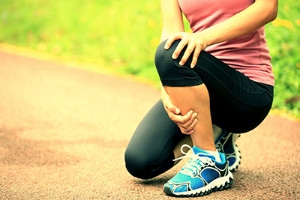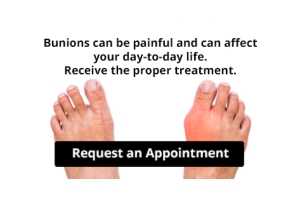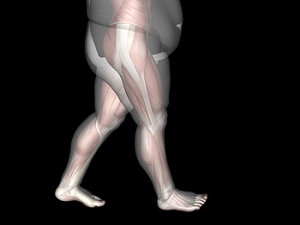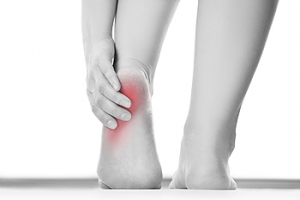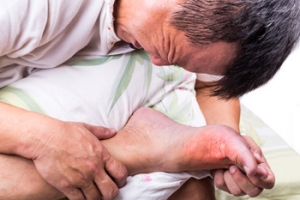
How Can I Protect My Feet While Running?
 Running is a very popular activity. However, one can seriously damage the feet if they do not practice following simple safety procedures. For runners who are just beginning, it is important to start slow and steady, being sure not to strain the ligaments of the lower extremities. Overuse is a common reason why many runners end up damaging their feet and developing conditions such as Achilles tendonitis. The body needs time to adapt to this new physical activity, which is why stretching before and after each run can help prepare the legs and feet, as well as cool them down after a run is completed. Plantar fasciitis is another foot condition that is common among runners, specifically affecting the heel region. To help prevent injury, it is also important to ensure you’re choosing the proper shoe for your style of running, and that you’re getting the support necessary for your level of activity. For more information on how to avoid obtaining a running injury, it is suggested that you consult with a podiatrist for professional advice.
Running is a very popular activity. However, one can seriously damage the feet if they do not practice following simple safety procedures. For runners who are just beginning, it is important to start slow and steady, being sure not to strain the ligaments of the lower extremities. Overuse is a common reason why many runners end up damaging their feet and developing conditions such as Achilles tendonitis. The body needs time to adapt to this new physical activity, which is why stretching before and after each run can help prepare the legs and feet, as well as cool them down after a run is completed. Plantar fasciitis is another foot condition that is common among runners, specifically affecting the heel region. To help prevent injury, it is also important to ensure you’re choosing the proper shoe for your style of running, and that you’re getting the support necessary for your level of activity. For more information on how to avoid obtaining a running injury, it is suggested that you consult with a podiatrist for professional advice.
All runners should take extra precaution when trying to avoid injury. If you have any concerns about your feet, contact Dr. Robert Marcus of Foot & Ankle Center of Teaneck. Our doctor will treat your foot and ankle needs.
How to Prevent Running Injuries
There are a lot of mistakes a runner can make prior to a workout that can induce injury. A lot of athletes tend to overstretch before running, instead of saving those workouts for a post-run routine. Deep lunges and hand-to-toe hamstring pulls should be performed after a workout instead of during a warmup. Another common mistake is jumping into an intense routine before your body is physically prepared for it. You should try to ease your way into long-distance running instead of forcing yourself to rush into it.
More Tips for Preventing Injury
- Incorporate Strength Training into Workouts - This will help improve the body’s overall athleticism
- Improve and Maintain Your Flexibility – Stretching everyday will help improve overall performance
- “Warm Up” Before Running and “Cool Down” Afterward – A warm up of 5-10 minutes helps get rid of lactic acid in the muscles and prevents delayed muscle soreness
- Cross-Training is Crucial
- Wear Proper Running Shoes
- Have a Formal Gait Analysis – Poor biomechanics can easily cause injury
If you have any questions, please feel free to contact our office located in Teaneck, NJ . We offer the newest diagnostic and treatment technologies for all your foot care needs.
Preventing Running Injuries
Over half of all runners encounter at least one injury per year. The reason for this is because many runners do not train properly. Injuries are almost inevitable due to the physical stress that running causes. While our bodies are great at adapting to the stress, it can only handle it in small doses. Injuries occur when the stress is applied too quickly for the body to handle, causing something within it to break down. With each step you take, your leg is absorbing two or three times your body’s weight.
Some of the most popular running injuries are shin splints, plantar fasciitis, Achilles tendinitis, and stress fractures. Shin splints cause pain along the inside or outside of the shins, and this pain is usually felt at the beginning of a run. The condition itself is defined as an inflammation of the muscles or tendons located around the shinbone. To treat shin splints, it is advised that you ice the shin area and stretch the calf muscles. To prevent this injury, you should slowly increase the distance you plan on running, instead of jumping into a more strenuous routine.
Achilles tendinitis is another common injury and it feels like pain along the back of the leg, toward the heel. This condition is defined as an inflammation of the Achilles which is the largest tendon in the body. The Achilles is responsible for connecting your calf muscles to the heel bone and it is caused by tight calf muscles. If you want to treat this injury, you should take a break from running to cross train with a low-impact activity.
There are a lot of common mistakes runners make that are causing them to experience injury. One mistake is stretching too much prior to warming up. If you plan to go on a run, you should warm up with a gentle 3-5-minute walk followed by a 5-minute run-walk. Another common mistake is jumping into a routine too quickly. Consequently, you should incorporate cross-training into your routine. If you are looking to get active, you should slowly weave running into an activity you are currently participating in. For example, you can try bike riding for 40 minutes followed by a 10-minute run.
Another way to prevent running injuries is to choose shoes that are appropriate for running. There are certain things you should look for when buying a new pair of running shoes. An important factor in these sneakers is flexibility. Running shoes should be capable of bending and flexing at the forefoot. However, you should not be able to bend the entire shoe in half with ease because this is a sign that the shoe does not have enough structure. Additionally, you should look for the fit of the running shoes you want to purchase. It is best to visit a specialty running shoe store to have your feet properly sized. Choosing shoes that fit properly can prevent many foot ailments.
If you are suffering from any pain from running injuries, you should make an appointment with your podiatrist to discover the underlying cause of your pain. He or she will be able to help treat your condition in the best way possible.
Are Bunions Affecting Your Everyday Life?
Why Do I Feel Pain in The Ball of My Foot?
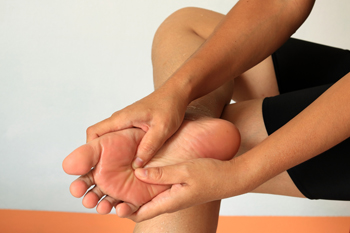 Morton’s neuroma is a condition that affects the nerves of the foot, often causing pain in the ball of foot. This condition can develop due to increased pressure, injury, or from ill-fitting footwear such as high heels. Patients affected with this condition often describe the feeling as if there is a pebble stuck inside of their shoe. Morton’s neuroma may cause a stinging, burning, or numbing sensation in the ball of the foot or toes. Some patients have found relief by wearing custom orthotics, shoe inserts, and by performing certain foot exercises. For a proper diagnosis and advised treatment plan, it is suggested that you consult with a podiatrist.
Morton’s neuroma is a condition that affects the nerves of the foot, often causing pain in the ball of foot. This condition can develop due to increased pressure, injury, or from ill-fitting footwear such as high heels. Patients affected with this condition often describe the feeling as if there is a pebble stuck inside of their shoe. Morton’s neuroma may cause a stinging, burning, or numbing sensation in the ball of the foot or toes. Some patients have found relief by wearing custom orthotics, shoe inserts, and by performing certain foot exercises. For a proper diagnosis and advised treatment plan, it is suggested that you consult with a podiatrist.
Morton’s neuroma is a very uncomfortable condition to live with. If you think you have Morton’s neuroma, contact Dr. Robert Marcus of Foot & Ankle Center of Teaneck. Our doctor will attend to all of your foot care needs and answer any of your related questions.
Morton’s Neuroma
Morton's neuroma is a painful foot condition that commonly affects the areas between the second and third or third and fourth toe, although other areas of the foot are also susceptible. Morton’s neuroma is caused by an inflamed nerve in the foot that is being squeezed and aggravated by surrounding bones.
What Increases the Chances of Having Morton’s Neuroma?
- Ill-fitting high heels or shoes that add pressure to the toe or foot
- Jogging, running or any sport that involves constant impact to the foot
- Flat feet, bunions, and any other foot deformities
Morton’s neuroma is a very treatable condition. Orthotics and shoe inserts can often be used to alleviate the pain on the forefront of the feet. In more severe cases, corticosteroids can also be prescribed. In order to figure out the best treatment for your neuroma, it’s recommended to seek the care of a podiatrist who can diagnose your condition and provide different treatment options.
If you have any questions, please feel free to contact our office located in Teaneck, NJ . We offer the newest diagnostic and treatment technologies for all your foot care needs.
Morton's Neuroma
Morton's Neuroma, also called Intermetatarsal Neuroma or Plantar Neuroma, is a condition that affects the nerves of the feet, usually the area between the third and fourth toe. Neuroma refers to a benign growth that can occur in different parts of the body. Morton's Neuroma strictly affects the feet. This condition causes the tissue around the nerves that lead to the toes becoming thick, causing pain in the ball of the foot.
This condition can be caused by injury, pressure or irritation. Normally no lump will be felt, but instead burning pain in the ball of the foot will be experienced. Numbness and tingling may also occur. With the onset of this condition, a person may feel pain when tight or narrow shoes are worn. As the condition worsens, the pain may persist for days, or even weeks.
Persistent foot pain should always be a concern. The foot should be examined by a podiatrist if pain persists longer than a few days with no relief from changing shoes. The earlier the foot is examined and treated, the less chance there will be for surgical treatment.
There are some factors that can play a role in the development of Morton's Neuroma. These include wearing ill-fitting shoes that cause pressure to the toes, such as high heels. Also, high impact exercise may contribute to the cause of this condition. Morton’s Neuroma may also develop if the foot sustains an injury. Another cause includes walking abnormally due to bunions or flat feet. This causes excessive pressure and irritates the tissue. At times, people are affected for no determinable reason.
Podiatrists can alleviate the effects of this condition using a treatment plan to help decrease the pain and heal the foot tissue. Depending upon the severity of the Morton's Neuroma, the treatment plan can vary. For cases that are mild to moderate, treatments may include applying padding to the arch to relieve pressure from the nerve and reduce compression while walking. Ice packs can also help reduce swelling. The podiatrist may also create a custom orthotic device to support the foot and reduce compression and pressure on the affected nerve. The doctor will probably advise against partaking in activities that cause constant pressure on the affected area. They may provide wider shoes to ease the pressure from the toes. If these treatments do not relieve the symptoms of this condition, the doctor may use injection therapy.
Surgical treatment may be recommended by the podiatrist if all other treatments fail to provide relief. Normally, the podiatric surgeon will decide on either a surgical procedure that involves removal of the affected nerve or will choose surgery to release the nerve. After examination, the surgeon will decide on the best approach to treat the problem.
Recovery varies according to the type of surgical procedure. The patient will also be instructed on the best shoe wear to prevent the return of this condition, along with changes to workout routines, if this was a cause. Preventative measures are important in ensuring the condition does not return.
Heel Pain May Be Present In Overweight People
 Research has indicated heel pain may be experienced by people who are overweight. This can be a result of the added weight the feet carry as daily activities are performed. Significant heel pain can be indicative of plantar fasciitis, and this occurs when the plantar fascia becomes inflamed. Patients who are overweight can notice symptoms of this condition, and it often begins with heel pain. The feet may feel better when excess weight is reduced, and this can be accomplished by consuming fewer calories. Additionally, it is beneficial to engage in a daily exercise routine, despite the discomfort the feet may feel. If you would like more information about how the feet are affected by obesity, please consult with a podiatrist.
Research has indicated heel pain may be experienced by people who are overweight. This can be a result of the added weight the feet carry as daily activities are performed. Significant heel pain can be indicative of plantar fasciitis, and this occurs when the plantar fascia becomes inflamed. Patients who are overweight can notice symptoms of this condition, and it often begins with heel pain. The feet may feel better when excess weight is reduced, and this can be accomplished by consuming fewer calories. Additionally, it is beneficial to engage in a daily exercise routine, despite the discomfort the feet may feel. If you would like more information about how the feet are affected by obesity, please consult with a podiatrist.
The more you weigh, the harder your feet must work to support your body. If you’re an obese individual and are concerned about your feet, contact Dr. Robert Marcus from Foot & Ankle Center of Teaneck. Our doctor can provide the care you need to keep you pain-free and on your feet.
Obesity and Your Feet
People who are overweight are putting more pressure on their ankles, knees, and hips as well as their feet. This unfortunately can lead to variety of different issues.
Problems & Complications Stemming from Obesity
- When the body is overweight, it tries to compensate by changing the way that it moves. An obese person may lean forward and put extra weight on the wrong part of the foot. This puts unnecessary stress on the feet.
- Obese people are also more likely to develop type II diabetes which is a condition that causes a lot of foot problems. People with diabetes often don’t feel the cuts and sores that they may have on their feet, which can lead to more complicated and severe issues.
- Plantar fasciitis is another foot condition that can be caused by obesity. Plantar fasciitis is an inflammation of the tissue along the bottom of the foot, which causes pain and stiffness while walking and climbing stairs.
If you have any questions, please feel free to contact our office located in Teaneck, NJ . We offer the newest diagnostic and treatment technologies for all your foot care needs.
Obesity and the Feet
Obesity is a common problem in American society. Approximately one third of the U.S. population is obese. Obesity is defined as a body mass index greater than 30. Obesity has the power to affect different aspects of the body, and one of the most common problems it causes is foot pain. There have been many studies that found a connection between an increased BMI and foot problems. A simple activity such as walking up a flight of stairs can increase pressure on the ankle by four to six times.
Being overweight causes the body to compensate for the extra weight by changing the way it moves. Consequently, people who struggle with obesity commonly have arch problems in their feet. Obesity causes the arch to break by stretching the ligaments and tendons that hold the bones in the foot together. When the arch lowers, the foot may eventually fall flat. Collapsed foot arches fail to provide adequate shock absorption which eventually leads to foot pain. Other conditions that may be caused by flat feet are pronation, plantar fasciitis, weak ankles, and shin splints.
Foot problems that are caused by obesity may be treated by wearing proper footwear. Proper shoes will allow your feet to have better circulation around the arch and ankle. Additionally, those with obesity often discover that typical heel pain remedies are not effective for them. They will find that their plantar fascia is easily injured, and it is often inflamed. The best way to treat this problem is to implement lifestyle changes. A few good ways to improve your diet are to reduce calories, fill up on fruits and veggies, and to limit sugars.
Custom foot orthotics can prevent foot problems if you’re carrying excess weight or are trying to lose weight. The purpose of orthotics is to provide shock absorption to decrease the amount of stress on the joints to prevent arthritis.
Sever’s Disease Symptoms
 When the tendons around the heel’s growth plate become inflamed, it is likely that Sever’s disease may develop. This condition is often common among growing teens who participate in sporting activities. Sever’s disease can be caused by repetitive stress to the heel. It can also develop when other structures of the body, such as bones, tendons, and muscles grow at different rates. Common symptoms include heel pain, redness, and swelling of the affected area. This condition may also make it uncomfortable or painful to walk and run, and can cause tenderness to the heel. For more information on how Sever’s disease can be treated, it’s suggested you consult with a podiatrist.
When the tendons around the heel’s growth plate become inflamed, it is likely that Sever’s disease may develop. This condition is often common among growing teens who participate in sporting activities. Sever’s disease can be caused by repetitive stress to the heel. It can also develop when other structures of the body, such as bones, tendons, and muscles grow at different rates. Common symptoms include heel pain, redness, and swelling of the affected area. This condition may also make it uncomfortable or painful to walk and run, and can cause tenderness to the heel. For more information on how Sever’s disease can be treated, it’s suggested you consult with a podiatrist.
Sever's disease often occurs in children and teens. If your child is experiencing foot or ankle pain, see Dr. Robert Marcus from Foot & Ankle Center of Teaneck. Our doctor can treat your child’s foot and ankle needs.
Sever’s Disease
Sever’s disease is also known as calcaneal apophysitis, which is a medical condition that causes heel pain I none or both feet. The disease is known to affect children between the ages of 8 and 14.
Sever’s disease occurs when part of the child’s heel known as the growth plate (calcaneal epiphysis) is attached to the Achilles tendon. This area can suffer injury when the muscles and tendons of the growing foot do not keep pace with bone growth. Therefore, the constant pain which one experiences at the back of the heel will make the child unable to put any weight on the heel. The child is then forced to walk on their toes.
Symptoms
Acute pain – Pain associated with Sever’s disease is usually felt in the heel when the child engages in physical activity such as walking, jumping and or running.
Highly active – Children who are very active are among the most susceptible in experiencing Sever’s disease, because of the stress and tension placed on their feet.
If you have any questions, please feel free to contact our office located in Teaneck, NJ . We offer the newest diagnostic and treatment technologies for all your foot and ankle injuries.
Sever's Disease
Sever’s disease, also known as calcaneal apophysitis is a common bone disorder that occurs during childhood. The disease is defined as an inflammation of the growth plate in the heel. When a child has a growth spurt, his heel bone grows faster than the muscles, tendons, and ligaments in his leg. This disease is a result of overuse. The people who are most likely to be affected by this disease are children who are in a growth spurt, especially boys who are from the ages of 5 to 13 years old. 60% of children with Sever’s disease have both heels involved.
Symptoms of this disease are heel pain that intensifies during running and jumping activities. The pain is typically localized to the posterior part of the heel. Symptoms may be severe, and they can easily interfere with daily activities. Children who play soccer, baseball, and basketball are more likely to develop Sever’s disease.
Your doctor will diagnose your child based on his or her symptoms, x-rays are generally not helpful in diagnosing this disease. Your doctor may examine both heels and ask your child questions about his or her activity level in sports. Your doctor may then use the squeeze test on your child’s heel to see if there is any pain. Nevertheless, some doctors might still use x-rays to rule out any other issues such as fractures, infections, and tumors.
Sever’s disease can be prevented by maintaining good flexibility while your child is growing. Another prevention method is to wear good-quality shoes that have firm support and a shock-absorbent sole. Sever’s disease can be treated by ceasing any activity that causes heel pain. You should apply ice to the injured heel for 20 minutes 3 times a day. Additionally, orthotics should be used for children who have high arches, flat feet, or bowed legs.
If you suspect your child has Sever’s disease, you should make an appointment with your podiatrist to have his or her foot examined. Your doctor may recommend nonsteroidal anti-inflammatory drugs (NSAIDs), such as ibuprofen or naproxen to relieve pain. In more severe cases, your child may need a cast to rest his or her heel. Fortunately, Sever’s disease does not cause long-term foot problems. After treatment, your child should start to feel better within two weeks to two months.
What Is Gout?
 The arthritic condition that is referred to as gout is known to cause severe pain and discomfort. It often impacts the joints in the big toe, and can be accompanied by redness and swelling. Many patients describe the pain as feeling like sharp pins between the joints, and this is caused by crystals that develop as a result of excess uric acid levels in the blood. This condition may also arise from eating foods that have high purine levels. These can include red meat, shellfish, and drinks that have large amounts of sugar. Additional reasons that can contribute to the onset of gout can consist of genetic factors, and medical conditions such as kidney stones. If you are afflicted with gout, it is strongly suggested that you are under the care of a podiatrist who can properly treat this condition.
The arthritic condition that is referred to as gout is known to cause severe pain and discomfort. It often impacts the joints in the big toe, and can be accompanied by redness and swelling. Many patients describe the pain as feeling like sharp pins between the joints, and this is caused by crystals that develop as a result of excess uric acid levels in the blood. This condition may also arise from eating foods that have high purine levels. These can include red meat, shellfish, and drinks that have large amounts of sugar. Additional reasons that can contribute to the onset of gout can consist of genetic factors, and medical conditions such as kidney stones. If you are afflicted with gout, it is strongly suggested that you are under the care of a podiatrist who can properly treat this condition.
Gout is a foot condition that requires certain treatment and care. If you are seeking treatment, contact Dr. Robert Marcus from Foot & Ankle Center of Teaneck. Our doctor will treat your foot and ankle needs.
What Is Gout?
Gout is a type of arthritis caused by a buildup of uric acid in the bloodstream. It often develops in the foot, especially the big toe area, although it can manifest in other parts of the body as well. Gout can make walking and standing very painful and is especially common in diabetics and the obese.
People typically get gout because of a poor diet. Genetic predisposition is also a factor. The children of parents who have had gout frequently have a chance of developing it themselves.
Gout can easily be identified by redness and inflammation of the big toe and the surrounding areas of the foot. Other symptoms include extreme fatigue, joint pain, and running high fevers. Sometimes corticosteroid drugs can be prescribed to treat gout, but the best way to combat this disease is to get more exercise and eat a better diet.
If you have any questions please feel free to contact our office located in Teaneck, NJ . We offer the newest diagnostic and treatment technologies for all your foot and ankle needs.



